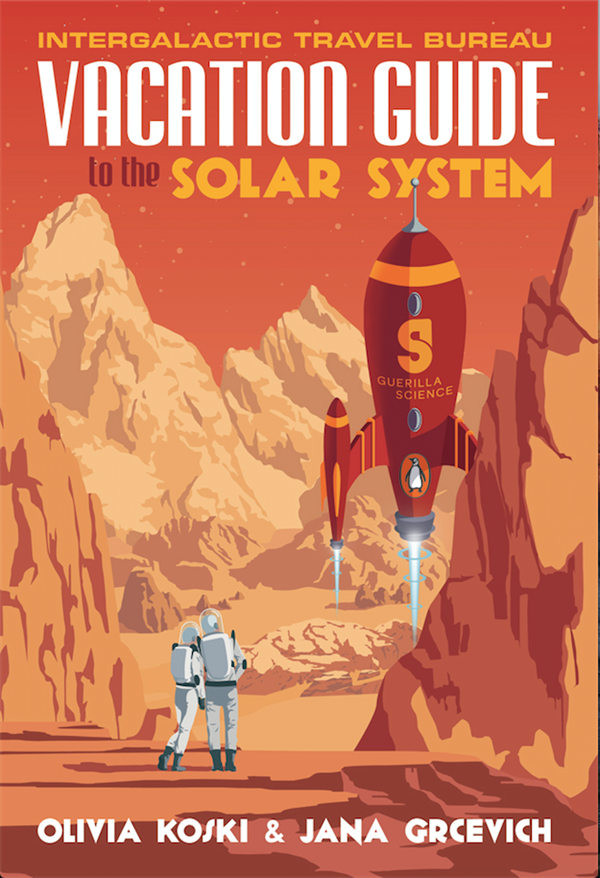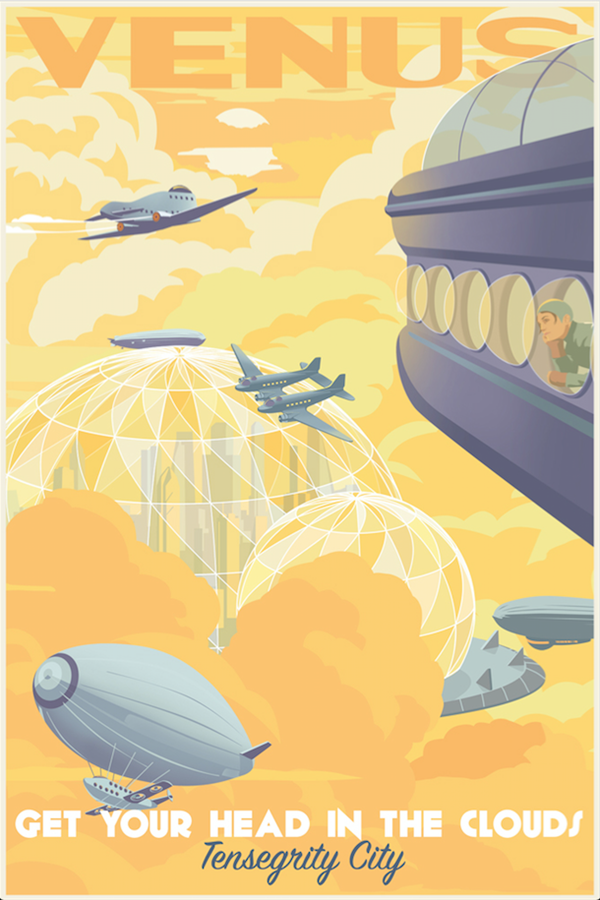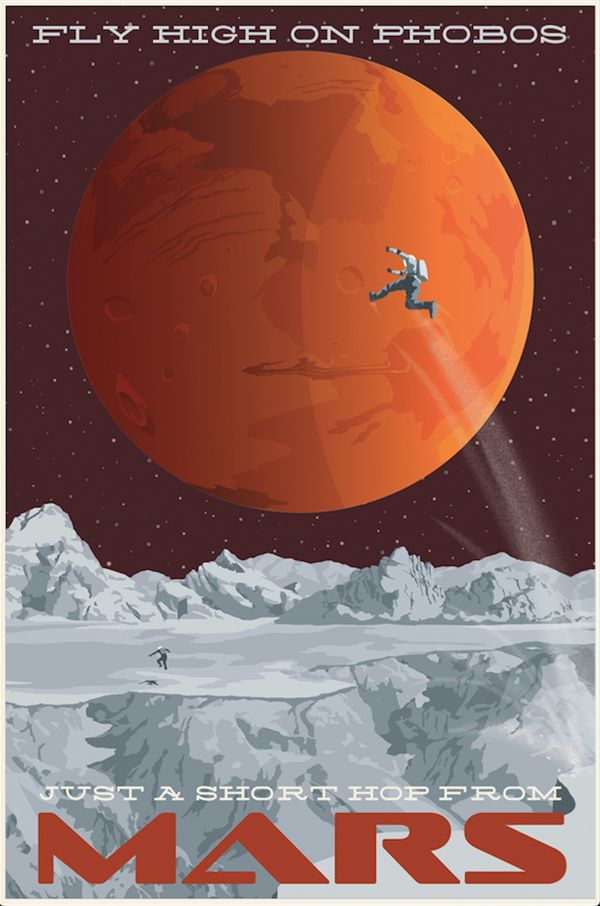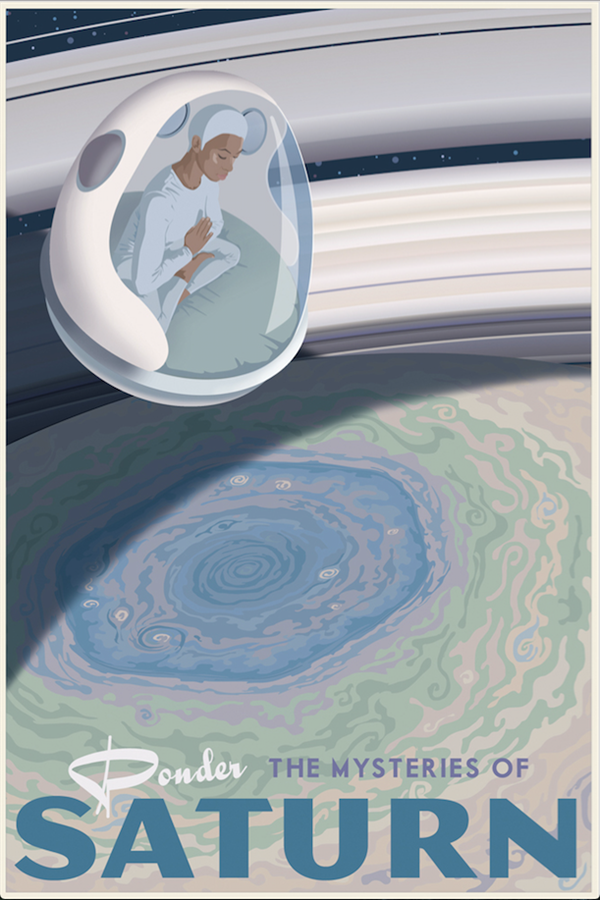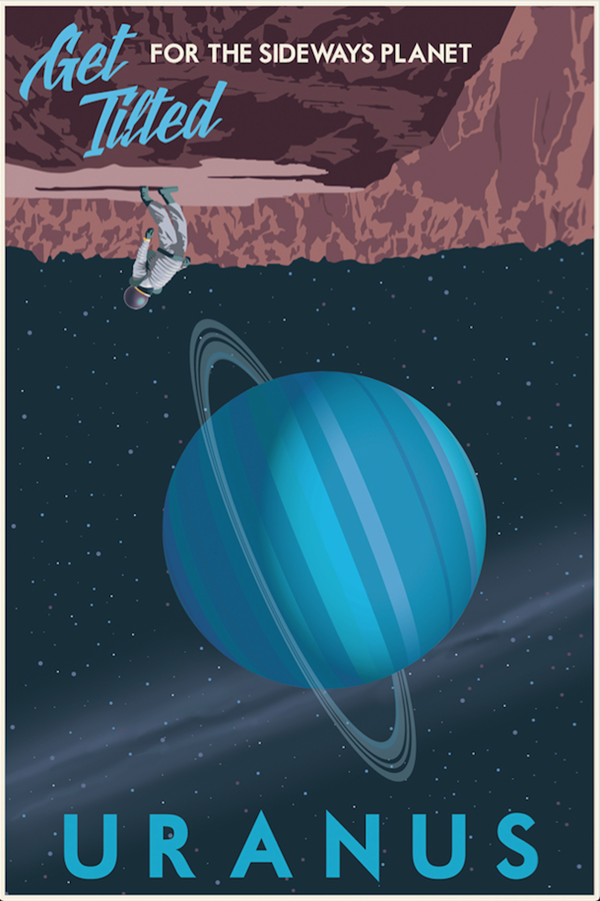Key Takeaways:
Imagine skydiving for dozens of miles through the skies of Saturn, luxuriating in floating cities nestled in the clouds of Venus, rappelling down Mariner Valley’s dramatic cliffs on Mars, or ski jumps on the methane snowcaps of Pluto. The new “Vacation Guide to the Solar System” by Olivia Koski and Jana Grcevich (Penguin Books, 2017) offers would-be explorers a guidebook to what such voyages might be like in the future, adventures driven by dreams and supported with science.
Many other tomes on the solar system have appeared over the years, ones often packed with beautiful photos and enchanting paintings. However, by recasting these locales not just as places to look at but as destinations to visit, the new book invites readers to imagine what it might be like to be there and do things.
Although the authors have taken some artistic license in their book when it comes to embellishments such as the existence of underground or floating cities, they stressed that such creative flourishes have a solid foundation in actual science — Koski is a one-time laser engineer at Lockheed Martin, and Grcevich has worked as an astronomer at the American Museum of Natural History.
“If you dig into NASA technical reports, you can find a ton of research into what missions to the planets around the solar system would be like,” Koski said. “The book might seem fantastical, but it reflects a lot of work going on at NASA for decades.”
Just like a regular guidebook, this new travel guide details ways to get to each destination, and the complications involved. For instance, to catch up with swift-moving Mercury, which travels 106,000 mph around the sun, roughly 40,000 mph faster than Earth, the book noted that it takes less fuel to leave the solar system than it does to visit Mercury without accidentally getting pulled into the sun. To land on the moon’s surface, it suggested either rocketing down or, more efficiently, riding a space elevator capsule from a space station down a long, super-strong cable. To get to Saturn in a hurry, it noted that in the 1960s, NASA’s Project Orion researched spaceships propelled by exploding nuclear bombs.
The chapters on each destination are packed with the kinds of details that would make tourists want to visit. “We really just started with the physical characteristics of each destination — what temperatures or gravity are like there, what its atmosphere is like — and thought about how those compared with Earth and what you could do at each place,” Koski said. “It’s really fun thinking of everyday leisure activities putting them on another planet, and seeing what happens.”
Highlights at each destination are many and varied:
* On the moon, aside from historical landmarks such as the Apollo landing sites, tourists can visit the mysterious Reiner Gamma anomaly in the Ocean of Storms, one of the largest sources of so-called “transient lunar phenomena” — strange flashes of light, changes in color, and other short-lived bursts of activity witnessed by observers on Earth for at least the past thousand years. The guidebook also offers diagrams and advice on how best to walk in the moon’s reduced gravity.
* On Mercury, tourists can watch a double sunset, with the sun appearing to set and temporarily rise again because of the odd nature of the scorched planet’s orbit. Tourists can also venture from Mercury’s underground cities to stroll with its slow-moving terminator line dividing day and night, which only travels at a reasonable walking pace of 2.2 mph, hundreds of times slower than Earth’s terminator.
* Venus can host cities in the sky because Earth air floats easily in Venus’ thick atmosphere — habitats filled with breathable air can rise like a helium balloon would on Earth. Tourists visiting the surface will need vehicles resembling submarines on wheels to deal with the dense atmosphere.
* Sunsets on Mars are colored the reverse on Earth because of the way sunlight scatters off dust in the red planet’s atmosphere — the sky far from the sun is reddish, while that around the sun is blue. On Phobos, the larger of Mars’ two moons, tourists can jump higher than Earth’s tallest building, the 2,722-foot-high Burj Khalifa in Dubai, with a single leap due to its low gravity.
* Jupiter’s draws include the 12,000-mile-wide Great Red Spot and auroras a thousand times more powerful than Earth’s. Its four largest so-called Galilean moons offer everything from fiery volcanoes to frigid ice sheets.
* Saturn’s attractions naturally include its rings and the mysterious hexagon near its north pole that is more than two and a half times wider than Earth. Tourists can also skydive into Saturn, although the guidebook warns to not begin skydives too high in altitude — “by the time these unlucky adventurers reach the denser gases, they are traveling so fast that they burn up like meteors.” It also notes that on Saturn’s largest moon Titan, the gravity is low enough and the atmosphere thick enough that tourists in wingsuits can fly under their own power, with perhaps a slight assist from thrusters.
* Uranus’ atmosphere is rich in helium. As such, “heliox clubs” in the aerial cities of Uranus offer a wide variety of flavored mixes of helium and oxygen, leading to nightly high-pitched karaoke contests.
* Pluto’s low gravity means that typical ski jumps will launch you 24 feet into the air. Tourists can also try skating with heated skates that turn nitrogen ice into gas.
Like many real guidebooks, this new book opens with advice on how to prepare for your trip. However, while real guidebooks might suggest that you pack sunscreen or a warm coat, this new book’s tips include pointers such as what spacesuit to bring and putting your affairs in order because of the numerous ways to die in space, such as getting burned alive, depressurization and nuclear incidents.
The book is illustrated with imaginary travel posters from Steve Thomas, conceiving of anything from acrobatic low-gravity bicycling on Mercury to deep-sea excursions on Jupiter’s moon Europa. “We fell in love with these whimsical posters immediately,” Koski said. And they are not just pretty pictures — “it was really important to us to get the science just right in them, into making sure they were as probably as possible, and not violating any major facts.”
Koski and Grcevich came up with their book while working together as mock travel agents at the Intergalactic Travel Bureau, a project of Guerilla Science, an organization that combines science with performance art. Other offerings from the Intergalactic Travel Bureau include a free virtual reality app that enables anyone with a smartphone and a simple VR viewer to explore places such as the moon, Mars and Europa.
The new guidebook often reads not just as a travel guide to the solar system, but from the future. “People might think we’re fantasizing, but it’s clear that reality of space travel is catching up to us — Richard Branson is talking about suborbital flights with Virgin Galactic, and Elon Musk hopes to deliver people to Mars, and recently announced he’d sold a trip to the moon to several unnamed clients,” Koski said. “These trips might one day no longer be exercises in imagination, but actual reality.”
“There’s a poster from 1918 I wanted printed in our book, which imagined travel to the other planets in our solar system with wonderful images of ships in the sky. It calculated that at the at-that-time great speeds of two miles a minute, it would take more than 2,500 years to get to Neptune. In comparison, the Voyager 2 spacecraft reached Neptune in less than 12 years by traveling at about 42,000 mph,” Koski said. “Who knows what might be possible 100 years from now?”
As to whether readers might expect a vacation guide to exoplanets in the future as a sequel, “we know very little about those places, so it’s difficult to write about them with as much science as we put in our book,” Koski said. “Maybe the sequel will come in 100 years — maybe we’ll have sent missions to exoplanets by then, just as we’ve sent missions to the other planets in our solar system.”

